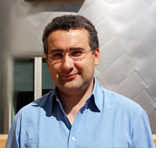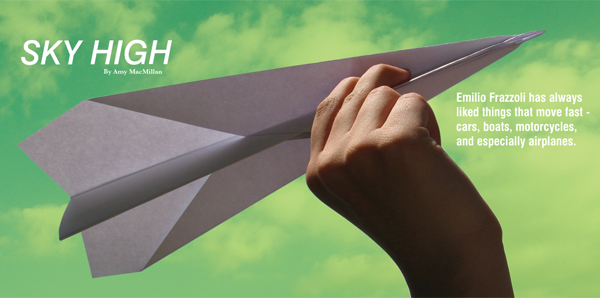“It’s in my blood,” he says. Growing up in Rome, Italy, the son of two physicists, Frazzoli, 36, dreamed of designing and flying his own aircraft when he was young. As an initial step, he wanted to practice with remote-controlled toy cars and airplanes, but at the time they were too expensive for his family to buy. This early curiosity has developed into a full-fledged research career: Frazzoli is now an aerospace engineer with an interest in designing the “brain” of robotic aircraft. He received his Ph.D. from the Institute in 2001, where he conducted his research at LIDS. After graduation he left to teach at the University of Illinois at Urbana-Champaign and the University of California in Los Angeles.
Frazzoli is now back at MIT, having returned this fall as the C.S. Draper Assistant Professor of Aeronautics and Astronautics. He says he was anxious to get back to the Institutebecause he missed the students, the faculty, and the vibrant environment. Frazzoli is also grateful, however, for his time at other universities where he gained a broader view of the academic world and exposure to new people and ideas.
Prior to earning his Ph.D., Frazzoli served as an ensign in the Italian Navy, and was a flight dynamics specialist in the spacecraft control center of Telespazio in Rome. He earned his M.S. in Aeronautical Engineering from the University of Rome La Sapienza in 1994. In 2001, Frazzoli was one of the few candidates for the final phase of the Italian Space Agency astronaut selection. He didn’t participate in the final round though, preferring to concentrate on completing his doctorate.
The hub of Frazzoli’s research has always been autonomous vehicles, with a focus on robotic aircraft and UAVs (Unmanned Aerial Vehicles). His doctoral thesis concentrated on unmanned helicopters and innovative control methods, enabling helicopters to fly autonomously and with unprecedented speed and agility. Frazzoli’s current research has expanded upon that earlier work, and he now focuses on the development of control software and algorithms for systems composed of several mobile robots, including UAVs and/or other vehicles, in a broad range of application areas, from environmental monitoring to national security. Carrying a variety of sensors, such as video cameras or acoustic sensors, these systems can provide human operators with timely information, dynamically collected across a geographically extended area as events unfold. This will dramatically impact the ability to model, study, and react to several critical, rapidly-evolving phenomena, including hurricanes, oils spills, and forest fires, much beyond the current limitations imposed by the fact that most of today’s sensors are static or remote (e.g., fixed monitoring stations or satellites).
Frazzoli’s interests lie mainly in the theoretical and algorithmic foundations of such systems, studying the fundamental trade-offs between design choices such as the number, characteristics, capabilities of individual robots, and the complexity, cost, and performance of the overall system. Even though most of this work involves the analysis and development of algorithms, a strong emphasis is also placed on their implementation and verification on a variety of experimental test beds. While at UCLA, Frazzoli and his students developed a small fleet of autonomous aircraft, and an indoor system composed of many “micro-cars,” which were used to demonstrate and validate their theoretical work. Similar test beds are under development at MIT. Students and post-docs in Frazzoli’s group come from different backgrounds, including aerospace, electrical engineering, computer science, and mathematics, and share a strong foundation in control theory, optimization, and algorithm design and implementation.
UAVs and mobile robots have found a niche in the military, but Frazzoli envisions their presence in the commercial sector. The aviation industry in particular stands to benefit from UAV technology, which could reduce costs and increase efficiency of service. Frazzoli notes that airplanes contain many cumbersome systems designed for taking care of the human pilot, such as air pressurization, ejection seats, and the canopy, all of which take up weight and space. If no humans are aboard, however, such features become unnecessary. Someday, unmanned flights may be ideal for the shipping industry, e.g., FedEx, which primarily deploys night flights with package cargo. Ultimately, however, the aviation industry is moving slowly on this front, and with good reason, Frazzoli says. The biggest issue is obviously safety. “In aviation, if things go wrong, they go terribly wrong,” he points out, adding that the necessary innovation is at least twenty years away. Frazzoli adds, however, that while many people may not feel comfortable flying in a pilot-free airplane, they already use commonplace “unmanned” machines like elevators and airport shuttles.
While the military already uses UAV technology, it’s efficiency could still be improved to maximize its benefits. When the military employs unmanned planes for surveillance or perilous missions, each UAV is accompanied by a ground crew of five or more people, who actually “fly” the plane from a safe location. Although this may be beneficial for safety, given the current technology, it’s inefficient to have multiple people controlling just one flight, Frazzoli says. If unmanned planes were engineered to be “smarter,” perhaps just one person could control several airplanes, freeing up manpower on the ground for other tasks.
Other issues also confront the widespread use and acceptance of UAV technology. For one thing, unmanned airplanes do not currently operate in the same airspace as manned aircraft, according to Frazzoli. It’s not clear yet how an unmanned aircraft would interact with a piloted plane. “From the point of view of the human pilot, there’s not enough trust yet in the automation,” he says. Ironically, an autonomous system is expected to be error-proof, but no one expects that human pilots are infallible, Frazzoli points out. “We accept the fact that human pilots can fail, but in a sense, we are more ready to accept human error than mechanical error,” he says. For example, though many of today’s commercial flights are automated for much of the journey, there must still be a pilot in the cockpit, ready to take over if something goes wrong.
Frazzoli’s work delves into such problems, moving forward with increased innovation in UAV technology. Such research is a perfect fit for LIDS, he says, where innovative, interdisciplinary approaches are the focus. With UAVs, for example, “you cannot really think about a single aircraft. You have to think about the ensembles of networks, and communication issues, and how they interact.” Once you understand the interlocking aspects of the work, “you have to ask yourself, how do you share and process the available information, and how do you make decisions? This is the core of the research at LIDS,” Frazzoli adds.
Like his colleagues, Frazzoli is busy with research and teaching in addition to his personal life. Frazzoli co-taught “Principles of Autonomy” with Nicholas Roy in the fall semester. In the Spring term, he will teach “Estimation and Control of Aerospace Systems.” In his spare time, he likes to play volleyball, tinker with computers and watch foreign movies. When he was a student at the Institute, he coordinated a popular foreign movie series, and was active in the European Club. Now, that he’s employed here, Frazzoli says he needs to make the full transition from being a student to a faculty member. He’s enthusiastic about that transition, however, which will be easier than his first arrival at MIT. Frazzoli vividly remembers his “culture shock” when he first stepped on American soil in 1999. “Honestly, my first year here was very hard. The culture shock is significant, and I felt I had to prove I was worth being here [at MIT],” he remembers. Today, when he visits his family in Italy twice a year, he experiences “reverse culture shock” as he readjusts to the bureaucratic wranglings of Italian culture. In addition to his family, he misses his homeland’s food, and rarely ventures to Italian restaurants in the states. Instead, he prefers his own home-cooked meals such as spaghetti alla carbonara. And, he owns as many remote-controlled “toy” vehicles as he can afford!




